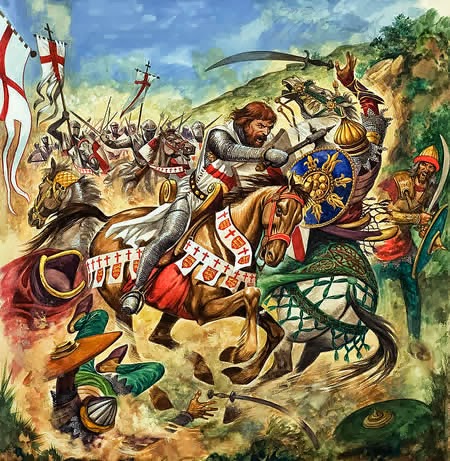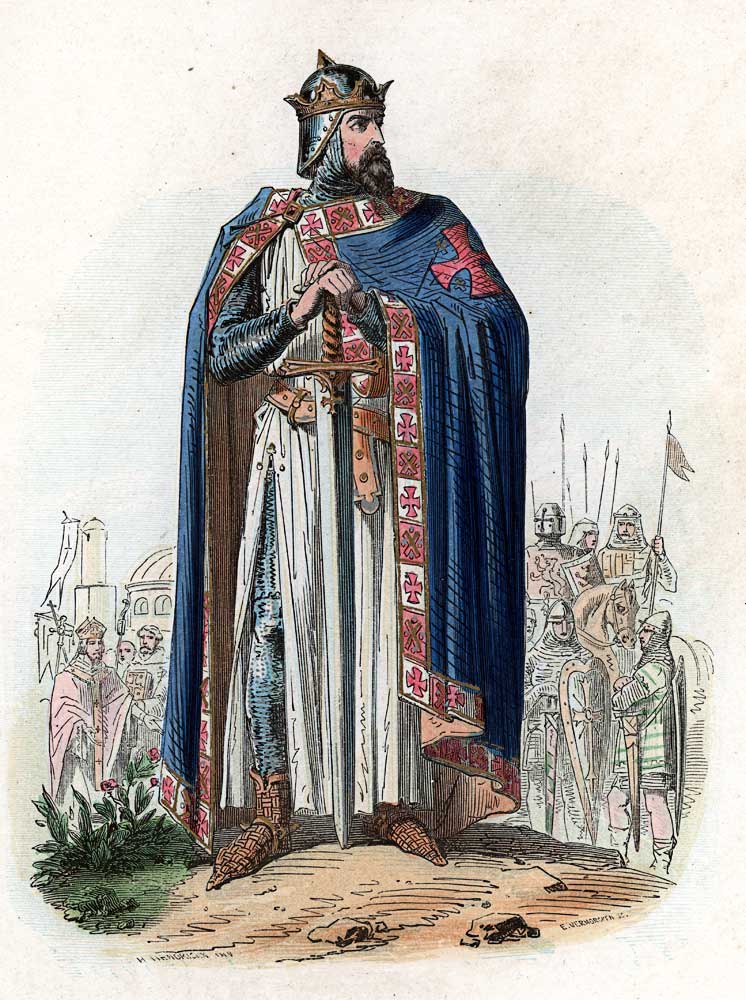 |
| Crusades |
In 1095 Pope Urban II incited the Crusades with a speech urging Christian armies to free the holy sites, especially Jerusalem, from Muslim control. The Crusades sparked a fire of religious fervor among thousands of young knights and other Christian believers. Other crusaders were adventurers, fortune seekers, and the poor and destitute.
In part the Roman Catholic Church sought the return of the Holy Land to Christian rule because the Seljuk Turks could not ensure the safety of Christian pilgrims. The Seljuk dynasty also extracted high taxes from and sometimes persecuted Christian pilgrims. The success of the early Crusades also reflected the disarray and weakness of the Arab-Muslim world in the 11th century.
The First Crusade (1096–99) was preceded by the Peasant Crusade, a crusade of hungry peasants; most died on the way to the Holy Land. Some 30,000 soldiers, mostly Franks and Germans, participated in the First Crusade. The crusaders crossed the Anatolia Peninsula and took Antioch in 1097.
  |
They then moved on to take Jerusalem in 1099 where they massacred thousands of civilians, mostly Eastern Orthodox Christians, considered as heretics by the Catholics, and Jews. First hand accounts describe the city running with blood knee-deep for several days.
After taking the city, the crusading knights gathered in the Church of the Holy Sepulcher and proclaimed Godfrey of Bouillon as king. Godfrey continued the war and extended crusader territory. Some knights settled more or less permanently in the new Crusader States, that at its greatest extent included the Syrian coast and Palestine.
The Crusader States replicated the feudal system prevalent in Europe. Fiefs were given to favored knights who were tied together for common defense. The crusaders built huge castles, often enlarging older Arab fortresses on high ground in strategic locations. Some of these castles, such as Beaufort Castle in Lebanon and the Krak des Chevaliers (Quala’at al-Husn) in Syria, still stand.
 |
| Godfrey of Bouillon king of crusader states |
Indigenous Arab villagers were little affected by the crusader rule as they were accustomed to giving tribute to local lords and fulfilling obligations of service during wartime. Likewise the Crusader States had little or no impact on the vast interior regions of the Arab-Muslim world. Under the crusaders, agriculture remained the mainstay of the economy. However the Crusader States were strategically and economically vulnerable.
Church and military orders were exempt from taxation and the Italians enjoyed special extraterritorial rights. Indeed the Italian city-states who provided transportation at high costs for many crusaders and financial backing, at high interest rates, for expeditions were among the chief beneficiaries of the Crusades. The Crusader States were also dependent on Italian city-states for supplies from Europe.
The Second Crusade (1146–48) led by King Louis VII of France and Emperor Conrad III followed the same geographic route as the First Crusade, but attempts to take Damascus failed. Conrad returned to Germany because of sickness, but Louis remained to make pilgrimages to the holy sites.
   |
At the time of the First Crusade Syria had been close to political collapse as rival powers struggled for ascendancy throughout the eastern Mediterranean after the collapse of the Abbasids. However Muslims challenged the crusaders and launched a series of counterattacks to regain control of Jerusalem and Syria.
Saladin proved the most formidable Muslim opponent. He united the Muslims and at the Battle of Horns of Hattin in the summer of 1187 stopped crusader expansion into the heartland of the Arab world. He then attacked crusader strongholds and took Jerusalem in 1187.
The fall of Jerusalem provoked the Third Crusade led by King Richard I of England, the Holy Roman Emperor Frederick I Barbarossa, and Philip II of France. Frederick drowned in Asia Minor in 1190 and after Philip and Richard quarreled, Philip returned to France. Without taking Jerusalem, Richard negotiated a truce with Saladin that ensured safe passage of Christian pilgrims into the city.
 |
| Krak des Chevaliers |
Although Pope Innocent III called for new attacks on Jerusalem, the crusading zeal was beginning to wane. When the Venetians demanded a high price to take crusading troops to Egypt, the Muslim military stronghold, the crusaders moved against Constantinople, the famed capital of the Byzantine Empire.
In the Fourth Crusade, the crusaders looted Constantinople and established a short-lived (1204–1261) Latin Empire there. The attack on Constantinople undermined the papacy and crippled the Byzantine Empire, which became more vulnerable to subsequent attacks by the Ottoman Turks. It also exacerbated animosities between Eastern Orthodox believers and the Roman Catholic Church. That schism persisted into the 21st century.
After Saladin’s death, divisions within the Muslim world enabled the crusaders to retain tenuous control of their territory, but Mamluk rulers resumed attacks from Egypt in the mid-13th century. Sultan Baybars (r. 1260–1277) launched annual attacks against the Frankish kingdoms, taking most of the Palestinian coastal cities.
He also defeated the Mongols, thereby preventing them from taking the coast. His military exploits were often favorably compared to those of Saladin. The Mamluks captured the city of Tripoli in 1289.
The Mamluk Sultan al-Ashraf Khalil took Acre, the last crusader outpost, in 1291. Signifying the end of the crusader presence, the city was looted and razed. Sultan Khalil was feted as a conquering hero on his return to Cairo. However as with many Mamluk rulers, rivals to the throne assassinated Khalil within a year of his victory.
The Crusades marked almost 200 years of intermittent warfare and sporadic coexistence between Christian Europe and the Muslim East. The exchanges fostered many negative cultural and religious stereotypes. Positive results included the introduction of many new goods, including brocades, perfumes, soaps, and foodstuffs, especially spices, to the West. Damascus retained its importance as a center for industry and commerce while Jerusalem was a religious center.
Some crusaders remained, intermarried, and assimilated into Muslim society. The Italian city-states established long-lasting commercial ties that continued even during times of open warfare. The wealth from this trade helped to finance the cultural flowering of the Renaissance. In the long term, the Crusades worsened Christian-Muslim relations and intensified religious animosities.
In spite of having been under Muslim rule for over 400 years, most of the population in the eastern Mediterranean was still Christian when the crusaders arrived. However the massacres of Eastern Orthodox Christians by the crusaders and their rude treatment of the local population ironically contributed to a massive conversion of Christians to Islam after the fall of the Crusader States.